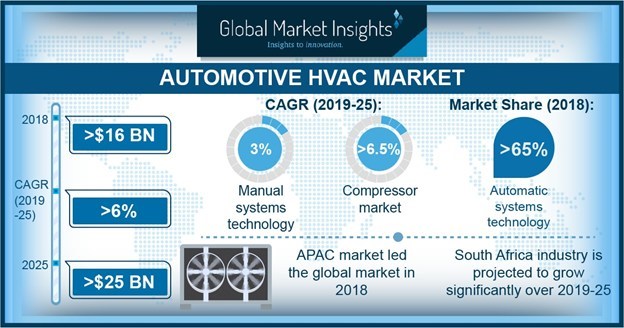With the automotive HVAC market about to surpass $25 billion by 2025, according to the latest report from Global Market Insights, Inc., government initiatives to control global warming are a major factor in the sector’s growth.
Government regulations on fuel emissions are compelling OEMs to integrate eco-friendly systems that decrease the load on the engine, thus reducing emissions. Variable-speed air movers and variable-speed electric compressors will play a significant role in implementing low emission strategies because they minimize time spent in reheat mode, where heat is introduced into the AC system for dehumidification. Moreover, OEMs are switching to CO2 refrigerants as a potential solution to address the increasing environmental impacts of these refrigerants, and this will create the need for additional sensors to be mounted in the cabin.
Europe is projected to be one of the prominent regions for the growth of the automotive HVAC market as it produces more premium passenger vehicles while American manufacturers focus on the truck and crossover vehicle market. The automotive industry in Germany is the most significant contributor to the country’s GDP. In 2017, over 20% of global passenger cars (16 million units) were produced in Germany. The German automotive industry caters to demands globally and produces the largest number of premium cars. Audi, Mercedes, and BMW are some of the well-established premium brands among automotive OEMs. German OEMs sell over 60% of all premium passenger cars across the world. AC automotive, Audi, BMW, Ford, Iveco, MAN, Mercedes, Neoplan, Volkswagen, Porsche are seen as the most innovative OEM suppliers with strong investment in R&D. This will create significant demand for thermal management systems, propelling automotive HVAC market growth.
Automatic HVAC systems are in high demand in passenger cars as these systems can monitor numerous cabin air parameters such as humidity and temperature set by driver or system specifications. These systems limit the fresh air inlet to the minimum by recirculating air through the air conditioning unit back to the cabin.
An HVAC system fuel consumption ranges up to three litres for every hundred kilometers, depending on driving cycles and climatic conditions. Automatic HVAC systems have been recorded to reduce fuel consumption by 35%, driving the growth of the automotive HVAC market.
A sample of the research report is available here.
Continuous R&D investments by companies involved in the automotive HVAC market have resulted in the development of eco-friendly systems. Compressors need high power of up to a thousand Watts for their operation. Efforts are being focused on reducing the energy consumption and active time to improve the efficiency of compressors, augmenting technological innovations in the automotive HVAC market. In addition, measures such as replacement of the mechanical expansion valve by an electrochemical valve controlled using a linear stepper motor and decreasing the temperature of airflow running over the evaporator to gain better control over the flow of refrigerant have been proposed. This is projected to contribute towards the market’s growth.
Companies in the automotive HVAC market landscape include Hanon Systems, Mahle Group, DuPont Automotive Systems, Denso Corporation, Johnson Electric, and Valeo, among others. The market is highly consolidated with companies focusing extensively on product differentiation.
Hanon Systems, for instance, has been investing heavily in expanding its thermal comfort portfolio by integrating innovative solutions with its HVAC systems, including CO2 sensor and high-efficiency blower scrolls for reduced noise and power consumption. The ultraviolet LED photocatalyst eliminates odor-causing bacteria from the evaporator and absorbed gases from outside the vehicle. In addition, the company offers customized omnifarious HVAC designs to automakers that allow them to enhance the interior cabin design, driving the automotive HVAC market.
Other OEMs are working on improving the acoustic efficiency of components and subsystems.
Source: Global Insights

